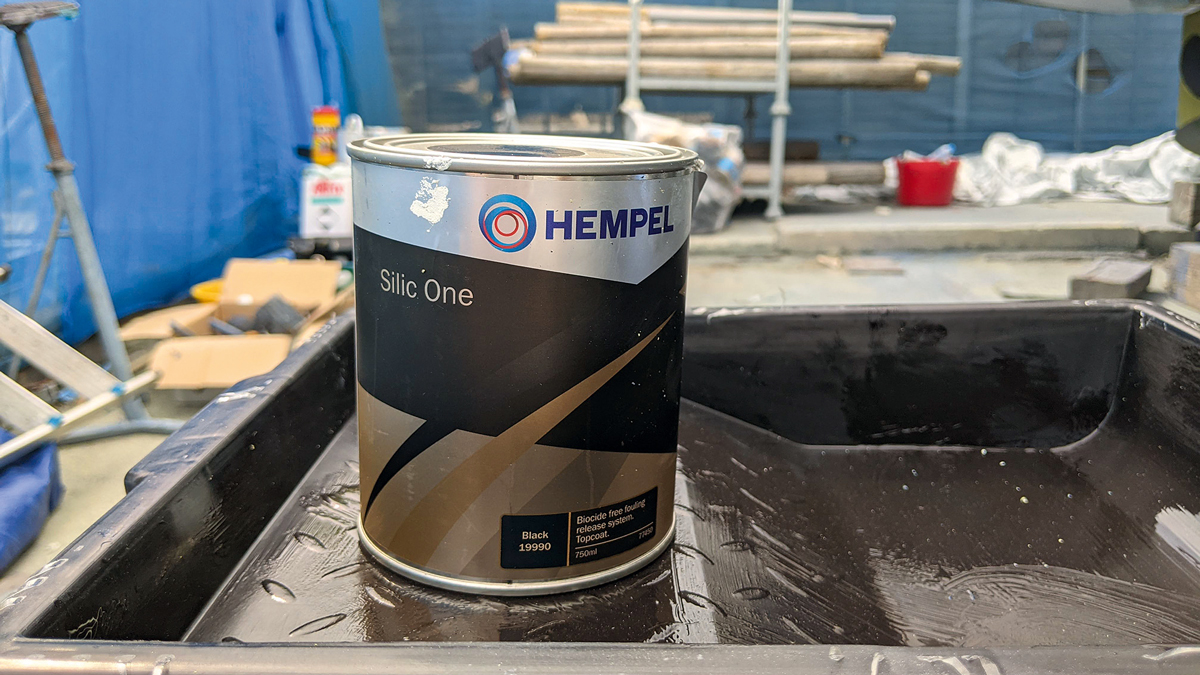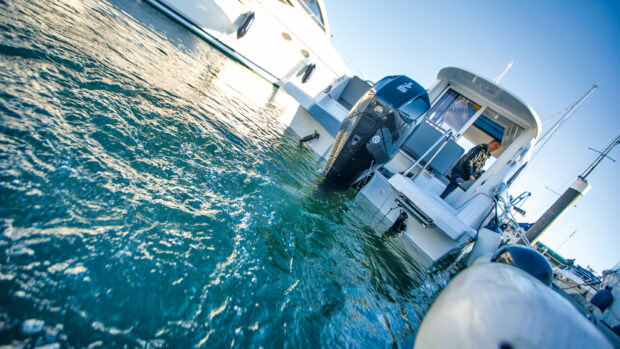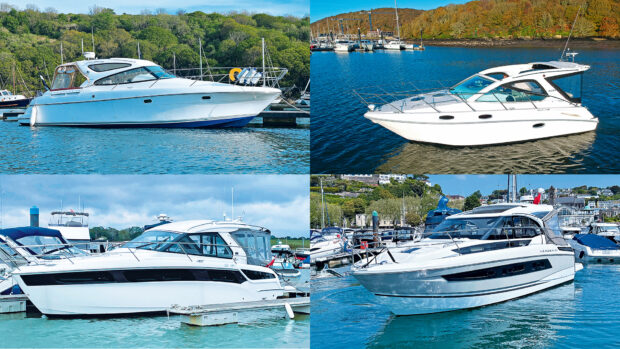In a seven month real-world test, we’ve been seeing how the latest non-biocide antifouling coatings compare with conventional copper-based paints.
Keeping your craft free of fouling is not just for appearance’s sake because even a small amount of weed and barnacles can make a substantial difference to its performance, and more importantly, its fuel efficiency.
However, as environmental regulations tighten on the level of biocides allowed in antifouling paints as well as the rules regarding application and removal, the industry is having to look for new solutions to keep the critters at bay.
Foul-release coatings using silicone and nanoparticles to prevent fouling getting a secure grip on the hull are an increasingly common sight on commercial vessels, but how well do they work on less intensively used leisure boats and how do they compare with each other and more conventional copper-based coatings?
To find out we proposed an on-water antifouling test of eight products, three of which are non-copper based foul release coatings, one of which is a long-term resin-based copper treatment that is also claimed to be kinder to the environment, plus four additional conventional copper-based eroding antifouling paints.
Article continues below…

Hempel Silic One: Is this the future of antifouling?

Finsulate: Could this prickly antifouling revolutionise boat maintenance?
Finding a test bed
We teamed up with our colleagues on Practical Boat Owner magazine to find a suitable test bed. The aim was to find a semi-displacement leisure boat in a suitably challenging location that was used regularly enough to give the foul-release coatings a good chance of washing off fouling before it formed an impenetrable bond but not so regularly or at such a high speed that it gave an unrealistic impression of how well they were working.
According to PBO’s last big antifouling test carried out at more than 20 locations around the UK, the Solent is one of the country’s highest fouling areas.
As it happens, marine electronics manufacturer Raymarine runs a 2008 Hardy Commodore 42 called Raymariner based in the Solent as a test bed and display facility for its latest kit.
It is used three to four times a week and is usually antifouled once a year with a copper-based eroding antifouling that keeps most of the fouling at bay.
Boat manager Neil Millerchip responded positively to our approach in February 2021, saying Raymariner had only just been lifted and recoated, “but we fully expect to have to lift and scrub every 4-6 months as the location we are in seems to be prone to lots of marine growth.”
With our test boat sorted we set about contacting antifouling suppliers to see what eco-friendly offerings were currently available.
We could only find four companies ready and able to supply products which specifically claim to be kinder on the environment for our test. They are as follows: Hempel, Seajet, Ceramic Pro and Coppercoat.
Non-biocide coatings
Hempel Silic One has been on the market for nine years already. In fact, in a previous MBY test, it actually outperformed all the other copper-based paints. We have also heard good reports since from a number of other boat owners who have used it.
Ceramic Pro is a ceramic-based nano-coating that has also been around for a number of years but predominantly as a high-end finishing product in the automotive world.
It was introduced to the marine market a couple of years ago too, initially as a protective high-gloss coating for use above the waterline, particularly on the performance boat side, but they also claim it works as a foul-release coating below the waterline.
The nano-coating of silica and titanium creates a hard and extremely smooth impermeable coat that’s said to be too slippery for plant and animal life to get hold of.
Seajet Bioclean-Eco is a new silicone-based coating. At the time of our test it wasn’t yet available to UK consumers but this product was launched to the public at the METS 2021 marine trade show in November.
Both Silic One and Seajet Bioclean have a softer, almost rubbery surface, more reminiscent of the waterproof adhesive product silicone than the translucent rock hard Ceramic Pro.
Coppercoat
The fourth of our antifoul coatings, which claims to be being kinder on the environment than traditional eroding antifoulings, is Coppercoat.
This well-known long-term antifouling uses pure copper particles sealed in super tough epoxy resin rather than copper oxide powder mixed into a softer paint matrix.
This means that instead of gradually leaching out copper oxide into the water as the water erodes the matrix, the copper granules remain stuck to the hull forming only a thin coating of copper oxide on the surface to repel fouling.
Recent environmental regulations have left the formula unchanged for this reason: although the copper content is the highest permitted by law, very little of it gets into the water column. It is also claimed to last for 10-15 years rather than having to be re-coated annually.
Traditional copper-based antifoulings
To see how they compare with conventional copper-based antifoulings we are also testing four biocidal paints: International Ultra 300, Hempel Tiger Extra, Jotun NonStop 2 and Seajet Shogun 033.
These four biocide coatings work in broadly the same manner: copper oxide is contained within a coating that gradually erodes over time, discouraging weed and crustaceans from taking root.
The Ultra 300 is a hard antifoul which, as the name suggests, leaves a tougher finish that erodes more slowly and can be burnished for a smoother finish, making it suitable for fast planing boats. The others are soft antifoulings which erode more quickly.
The trouble with all these products is that even though copper content is now carefully controlled, much of it ends up in the water column.
Concentrations increase wherever boats moor in large groups, such as in marinas, and the process of wet sanding, jet blasting and scraping creates piles of waste material that need to be disposed of correctly.
Antifouling test protocol
Before applying the test products, we decided to shot-blast all the existing coatings off and return to gelcoat to provide a completely level playing field for the test.
We started work on a Saturday in mid-June in very warm conditions and finished just in time for relaunch the following Thursday. Thankfully the rain held off the entire time.
Coppercoat applied their own product, as did Ceramic Pro. The former can be bought as a DIY product but the latter is only available through Ceramic Pro’s network of professional applicators.
All the rest were applied by us according to the instructions. To avoid any risk of cross-contamination, we used different rollers for each stage of each coating (primers, tie-coats and antifoulings) and the recommended rollers and tray liners to prevent contamination.
Each strip stretches from boot-top to boot-top underneath the mid-section of the hull where all the coatings will be exposed to a similar level of light and won’t be affected by lifting strops.
We also painted a static board with the same coatings at the same time to see how that compares with our results from the boat, as did Ceramic Pro and Coppercoat.
To verify any wet or dry film coating thicknesses, we used a film thickness gauge. We masked off a 2cm section between each strip and at the very end, where possible, we used a small pot of International Trilux in white to coat each untreated divider line.
Antifouling test results
You can read the full results of our antifouling group test now, right here on mby.com


















